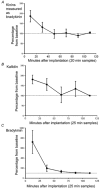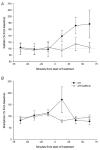Contraction-related factors affect the concentration of a kallidin-like peptide in rat muscle tissue
- PMID: 12356886
- PMCID: PMC2290579
- DOI: 10.1113/jphysiol.2002.025106
Contraction-related factors affect the concentration of a kallidin-like peptide in rat muscle tissue
Abstract
In order to study the effects of the manipulation of various factors related to muscular activity on the concentration of kinins in muscular tissue, a microdialysis probe was implanted in the adductor muscle of the hindlimb in anaesthetized rats. After collection of baseline samples, the perfusion fluid was changed to a Ringer solution containing sodium lactate (10 or 20 mM), adenosine (50 or 100 microM) or a lower pH (7.0 or 6.6). Whereas perfusion with lactate did not have any significant effect on the concentration of kinins in the dialysate, the perfusion with a lower pH or with adenosine dose-dependently increased the kinin content in the samples. In a second microdialysis experiment, by using specific radioimmunoassays (RIA) for bradykinin and kallidin, we observed that about 70 % of the total kinins dialysed from rat muscle are a kallidin-like peptide. Also, the simultaneous perfusion with 100 microM caffeine totally abolished the increase in kinin levels induced by the perfusion at pH 6.6. In a third experiment, soleus muscles from rat were stimulated in vitro during 30 min in the presence or absence of 77 microM caffeine. Electrically stimulated contraction, but not the addition of 10 mU ml(-1) insulin, induced an increase in the concentration of the kallidin-like peptide in the buffer. This effect was totally prevented by the addition of the adenosine antagonist caffeine. These results show that a kallidin-like peptide is released from rat muscle, and that its production is enhanced by muscle activity. Furthermore, the increase in kinin peptides during muscle contraction may be mediated by an increase in adenosine levels.
Figures





Similar articles
-
Kinin peptides in human trapezius muscle during sustained isometric contraction and their relation to pain.J Appl Physiol (1985). 2005 Feb;98(2):534-40. doi: 10.1152/japplphysiol.01340.2003. Epub 2004 Oct 8. J Appl Physiol (1985). 2005. PMID: 15475593 Clinical Trial.
-
A kallidin-like peptide is a protective cardiac kinin, released by ischaemic preconditioning of rat heart.Br J Pharmacol. 2005 Dec;146(7):952-7. doi: 10.1038/sj.bjp.0706402. Br J Pharmacol. 2005. PMID: 16231012 Free PMC article.
-
Kallidin-like peptide mediates the cardioprotective effect of the ACE inhibitor captopril against ischaemic reperfusion injury of rat heart.Br J Pharmacol. 2006 Jul;148(6):825-32. doi: 10.1038/sj.bjp.0706799. Epub 2006 Jun 12. Br J Pharmacol. 2006. PMID: 16770319 Free PMC article.
-
Caffeine and theophylline block insulin-stimulated glucose uptake and PKB phosphorylation in rat skeletal muscles.Acta Physiol (Oxf). 2010 Sep;200(1):65-74. doi: 10.1111/j.1748-1716.2010.02103.x. Epub 2010 Feb 20. Acta Physiol (Oxf). 2010. PMID: 20180783
-
The kinin system in rhinitis and asthma.Clin Rev Allergy Immunol. 1998 Winter;16(4):351-64. doi: 10.1007/BF02737656. Clin Rev Allergy Immunol. 1998. PMID: 9926285 Review.
Cited by
-
Rat tissue kallikrein releases a kallidin-like peptide from rat low-molecular-weight kininogen.Br J Pharmacol. 2005 Dec;146(7):958-63. doi: 10.1038/sj.bjp.0706409. Br J Pharmacol. 2005. PMID: 16231010 Free PMC article.
-
Exploring the human plasma proteome for humoral mediators of remote ischemic preconditioning--a word of caution.PLoS One. 2014 Oct 15;9(10):e109279. doi: 10.1371/journal.pone.0109279. eCollection 2014. PLoS One. 2014. PMID: 25333471 Free PMC article.
-
Neurochemical mechanism of muscular pain: Insight from the study on delayed onset muscle soreness.J Physiol Sci. 2024 Jan 24;74(1):4. doi: 10.1186/s12576-023-00896-y. J Physiol Sci. 2024. PMID: 38267849 Free PMC article. Review.
-
Bradykinin and nerve growth factor play pivotal roles in muscular mechanical hyperalgesia after exercise (delayed-onset muscle soreness).J Neurosci. 2010 Mar 10;30(10):3752-61. doi: 10.1523/JNEUROSCI.3803-09.2010. J Neurosci. 2010. PMID: 20220009 Free PMC article.
-
Upregulated glial cell line-derived neurotrophic factor through cyclooxygenase-2 activation in the muscle is required for mechanical hyperalgesia after exercise in rats.J Physiol. 2013 Jun 15;591(12):3035-48. doi: 10.1113/jphysiol.2012.249235. Epub 2013 Apr 15. J Physiol. 2013. PMID: 23587883 Free PMC article.
References
-
- Aslesen R, Jensen J. Effects of epinephrine on glucose metabolism in contracting rat skeletal muscles. American Journal of Physiology. 1998;275:E448–456. - PubMed
-
- Babenko V, Graven-Nielsen T, Svensson P, Drewes AM, Jensen TS, Arendt-Nielsen L. Experimental human muscle pain and muscular hyperalgesia induced by combinations of serotonin and bradykinin. Pain. 1999;82:1–8. - PubMed
-
- Bangsbo J. Vasoactive substances in the interstitium of contracting skeletal muscle examined by microdialysis. Proceedings of the Nutrition Society. 1999;58:925–933. - PubMed
-
- Bockman EL, McKenzie JE. Tissue adenosine content in active soleus and gracilis muscles of cats. American Journal of Physiology. 1983;244:H552–559. - PubMed
Publication types
MeSH terms
Substances
LinkOut - more resources
Full Text Sources
Research Materials

